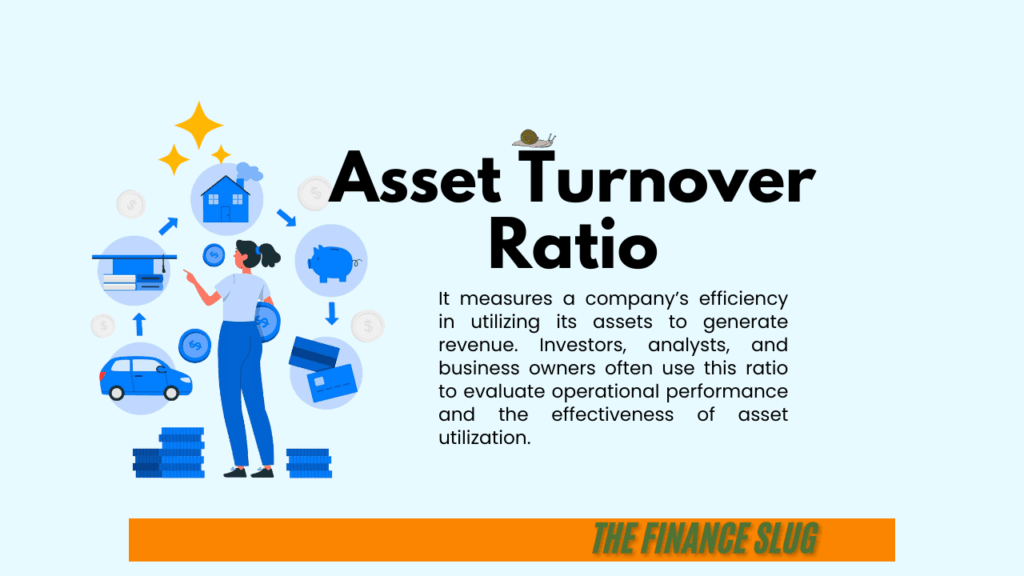
Asset Turnover Ratio is a crucial financial metric that measures a company’s efficiency in utilizing its assets to generate revenue. Investors, analysts, and business owners often use this ratio to evaluate operational performance and the effectiveness of asset utilization.
In this blog, we will break down the asset turnover ratio, explaining its formula, how to calculate it, its importance, and ways to improve it.
What is the Asset Turnover Ratio?
The asset turnover ratio is a financial metric that indicates how efficiently a company uses its assets to produce sales. A higher ratio suggests that the company generates more revenue per unit of assets, reflecting efficient management. Conversely, a lower ratio might indicate inefficiencies or underutilization of assets.
Key Takeaway:
- It answers the question: “How effectively is the company using its assets to generate revenue?”
Formula for Asset Turnover Ratio
The formula for calculating the asset turnover ratio is:
Asset Turnover Ratio=Net Sales/Average Total Assets
Where:
- Net Sales: Total revenue minus returns, allowances, and discounts.
- Average Total Assets: The average of the beginning and ending total assets for the period.
Example Calculation
Let’s assume Company XYZ reported:
- Net Sales: $1,000,000
- Beginning Assets: $400,000
- Ending Assets: $600,000
Step 1: Calculate Average Total Assets
Average Total Assets=Beginning Assets+Ending Assets2
Average Total Assets=400,000+600,0002=500,000
Step 2: Calculate the Asset Turnover Ratio
Asset Turnover Ratio=1,000,000/500,000=2.0
Interpretation: For every $1 of assets, the company generates $2 in revenue.
Why is the Asset Turnover Ratio Important?
1. Evaluates Operational Efficiency
It shows how effectively a business is using its resources to generate sales. Higher efficiency often indicates better performance.
2. Supports Strategic Decision-Making
By comparing this ratio across time periods or industry benchmarks, businesses can identify areas for improvement or make informed decisions.
3. Industry-Specific Insights
The “ideal” asset turnover ratio varies by industry. For example:
- Retail businesses may have higher ratios due to fast inventory turnover.
- Manufacturing companies may have lower ratios because of capital-intensive operations.
4. Attracts Investors
A strong asset turnover ratio can indicate that a company is well-managed, making it attractive to potential investors.
Factors Affecting Asset Turnover Ratio
Several factors can influence this ratio:
- Asset Composition: The nature of assets (fixed vs. current) impacts the ratio.
- Industry Norms: Industries with high revenue but low asset bases tend to have higher ratios.
- Economic Conditions: Economic downturns can reduce sales, lowering the ratio.
- Operational Changes: New investments or changes in asset structure can temporarily affect efficiency.
How to Improve the Asset Turnover Ratio
- Optimize Inventory Management: Reducing excess inventory can improve sales relative to asset value.
- Upgrade Technology: Implementing advanced tools can enhance operational efficiency.
- Focus on Core Operations: Divesting non-core or underperforming assets can help streamline operations.
- Boost Sales: Marketing and sales strategies that drive revenue can naturally improve the ratio.
Limitations of Asset Turnover Ratio
While insightful, the asset turnover ratio has its limitations:
- Does Not Show Profitability: A high ratio doesn’t guarantee high profits.
- Industry-Specific Variations: Comparisons across industries can be misleading.
- Ignores Asset Age: Older assets with lower book values may inflate the ratio.
Industry Benchmarks for Asset Turnover Ratio
The interpretation of the ratio depends on industry standards:
- Retail: Typically higher (e.g., 2.5 to 3.5) due to frequent inventory turnover.
- Manufacturing: Moderate ratios (e.g., 0.5 to 1.5) are common due to asset-intensive operations.
- Tech Companies: Often have higher ratios due to minimal physical assets.
Final Thoughts
The Asset Turnover Ratio is a vital tool for assessing how effectively a company uses its assets to generate revenue. While it is a valuable indicator of operational efficiency, it should not be viewed in isolation. Combining it with other metrics like profit margins and return on assets provides a more comprehensive view of financial health.
By understanding and leveraging this ratio, businesses can enhance their performance, align with industry standards, and attract potential investors.

